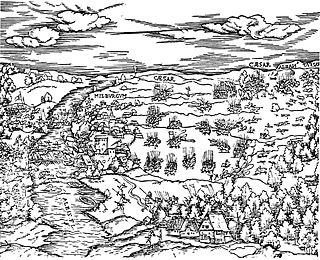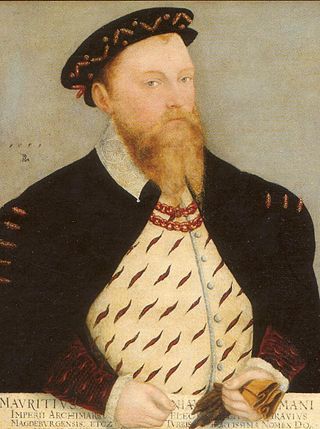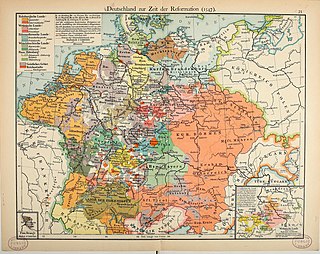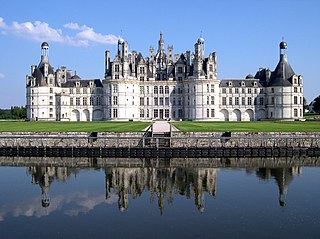Related Research Articles

Maximilian II was Holy Roman Emperor from 1564 until his death in 1576. A member of the Austrian House of Habsburg, he was crowned King of Bohemia in Prague on 14 May 1562 and elected King of Germany on 24 November 1562. On 8 September 1563 he was crowned King of Hungary and Croatia in the Hungarian capital Pressburg. On 25 July 1564 he succeeded his father Ferdinand I as ruler of the Holy Roman Empire.

The Schmalkaldic League was a military alliance of Lutheran princes within the Holy Roman Empire during the mid-16th century.

The Catholic League was a coalition of Catholic states of the Holy Roman Empire formed 10 July 1609. While initially formed as a confederation to act politically to negotiate issues vis-à-vis the Protestant Union, modelled on the more intransigent ultra-Catholic French Catholic League (1576), it was subsequently concluded as a military alliance "for the defence of the Catholic religion and peace within the Empire".

The Protestant Union, also known as the Evangelical Union, Union of Auhausen, German Union or the Protestant Action Party, was a coalition of Protestant German states. It was formed on 14 May 1608 by Frederick IV, Elector Palatine in order to defend the rights, land and safety of each member. It included both Calvinist and Lutheran states, and dissolved in 1621.

The Peace of Augsburg, also called the Augsburg Settlement, was a treaty between Charles V, Holy Roman Emperor, and the Schmalkaldic League, signed in September 1555 at the imperial city of Augsburg. It officially ended the religious struggle between the two groups and made the legal division of Christianity permanent within the Holy Roman Empire, allowing rulers to choose either Lutheranism or Roman Catholicism as the official confession of their state. However, the Peace of Augsburg arrangement is also credited with ending much Christian unity around Europe. Calvinism was not allowed until the Peace of Westphalia.

Cuius regio, eius religio is a Latin phrase which literally means "whose realm, their religion" – meaning that the religion of the ruler was to dictate the religion of those ruled. This legal principle marked a major development in the collective freedom of religion within Western civilization. Before tolerance of individual religious divergences became accepted, most statesmen and political theorists took it for granted that religious diversity weakened a state – and particularly weakened ecclesiastically-transmitted control and monitoring in a state. The principle of "cuius regio" was a compromise in the conflict between this paradigm of statecraft and the emerging trend toward religious pluralism developing throughout the German-speaking lands of the Holy Roman Empire. It permitted assortative migration of adherents to just two theocracies, Roman Catholic and Lutheran, eliding other confessions.

Philip I, Landgrave of Hesse, nicknamed der Großmütige, was a German nobleman and champion of the Protestant Reformation, notable for being one of the most important of the early Protestant rulers in Germany.

The Battle of Mühlberg took place near Mühlberg in the Electorate of Saxony in 1547, during the Schmalkaldic War. The Catholic princes of the Holy Roman Empire led by the Holy Roman Emperor Charles V decisively defeated the Lutheran Schmalkaldic League of Protestant princes under the command of Elector John Frederick I of Saxony and Landgrave Philip I of Hesse.

The Schmalkaldic War was the short period of violence from 1546 until 1547 between the forces of Emperor Charles V of the Holy Roman Empire, commanded by the Duke of Alba and the Duke of Saxony, and the Lutheran Schmalkaldic League within the domains of the Holy Roman Empire.

The Diet of Augsburg were the meetings of the Imperial Diet of the Holy Roman Empire held in the German city of Augsburg. Both an Imperial City and the residence of the Augsburg prince-bishops, the town had hosted the Estates in many such sessions since the 10th century. In 1282, the diet of Augsburg assigned the control of Austria to the House of Habsburg. In the 16th century, twelve of thirty-five imperial diets were held in Augsburg, a result of the close financial relationship between the Augsburg-based banking families such as the Fugger and the reigning Habsburg emperors, particularly Maximilian I and his grandson Charles V. Nevertheless, the meetings of 1518, 1530, 1547/48 and 1555, during the Reformation and the ensuing religious war between the Catholic emperor and the Protestant Schmalkaldic League, are especially noteworthy. With the Peace of Augsburg, the cuius regio, eius religio principle let each prince decide the religion of his subjects and inhabitants who could not conform could leave.

The Three Bishoprics constituted a government of the Kingdom of France consisting of the dioceses of Metz, Verdun, and Toul within the Lorraine region. The three dioceses had been Prince-bishoprics of the Holy Roman Empire until they were seized by King Henry II of France between April and June 1552. At the end of the Thirty Years' War, they were officially ceded to France by the 1648 Peace of Westphalia.

Maurice was Duke (1541–47) and later Elector (1547–53) of Saxony. His clever manipulation of alliances and disputes gained the Albertine branch of the Wettin dynasty extensive lands and the electoral dignity.

The Augsburg Interim was an imperial decree ordered on 15 May 1548 at the 1548 Diet of Augsburg by Charles V, Holy Roman Emperor, who had just defeated the forces of the Protestant Schmalkaldic League in the Schmalkaldic War of 1546/47. Although it ordered Protestants to readopt traditional Catholic beliefs and practices, including the seven Sacraments, it allowed for Protestant clergymen the right to marry and for the laity to receive communion in both kinds. It is considered the first significant step in the process leading to the political and religious legitimization of Protestantism as a valid alternative Christian creed to Roman Catholicism finally realized in the 1552 Peace of Passau and the 1555 Peace of Augsburg. The Interim became Imperial law on 30 June 1548. The Pope advised all bishops to abide by the concessions made to the Protestants in the Interim in August 1549.

The Treaty of Chambord was an agreement signed on 15 January 1552 at the Château de Chambord between the Catholic King Henry II of France and three Protestant princes of the Holy Roman Empire led by Elector Maurice of Saxony. Based on the terms of the treaty, Maurice ceded the vicariate over the Three Bishoprics of Toul, Verdun, and Metz to France. In return, he was promised military and economic aid from Henry II in order to fight against the forces of Emperor Charles V of Habsburg.

Otto Truchsess von Waldburg was Prince-Bishop of Augsburg from 1543 until his death and a Cardinal of the Catholic Church.

The European wars of religion were a series of wars waged in Europe during the 16th, 17th and early 18th centuries. Fought after the Protestant Reformation began in 1517, the wars disrupted the religious and political order in the Catholic countries of Europe, or Christendom. Other motives during the wars involved revolt, territorial ambitions and great power conflicts. By the end of the Thirty Years' War (1618–1648), Catholic France had allied with the Protestant forces against the Catholic Habsburg monarchy. The wars were largely ended by the Peace of Westphalia (1648), which established a new political order that is now known as Westphalian sovereignty.
The Leipzig Interim was one of several temporary settlements between the Emperor Charles V and German Lutherans following the Schmalkaldic War. It was presented to an assembly of Saxon political estates in December 1548. Though not adopted by the assembly, it was published by its critics under the name "Leipzig Interim."

The Augsburg Confession, also known as the Augustan Confession or the Augustana from its Latin name, Confessio Augustana, is the primary confession of faith of the Lutheran Church and one of the most important documents of the Protestant Reformation. The Augsburg Confession was written in both German and Latin and was presented by a number of German rulers and free-cities at the Diet of Augsburg on 25 June 1530.
An imperial election was held in Regensburg on 28 November 1562 to select the emperor of the Holy Roman Empire.

The Second Schmalkaldic War, also known as the Princes' Revolt, was an uprising of German Protestant princes led by elector Maurice of Saxony against the Catholic emperor Charles V that broke out in 1552. Historians disagree whether the war concluded the same year with the Peace of Passau in August, or dragged on until the Peace of Augsburg in September 1555. The Protestant princes were supported by King Henry II of France, who was a Catholic, but sought to use the opportunity to expand his territory in modern-day Lorraine.